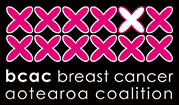Herceptin and HER2-positive breast cancer
Herceptin is a targeted therapy for HER2-positive breast cancer.
HER2 stands for human epidermal growth factor 2, a protein located on the surfaces of cells involved in controlling cell proliferation. Breast cancer tumours that have higher-than-normal levels of HER2 are said to be ‘over-expressing’ this protein, and are referred to as HER2 positive. About 23% of breast cancers are HER2 positive.
Herceptin (generic name: trastuzumab) is a drug designed to lock onto and shut down the HER2 protein. Its molecular structure is based on an antibody that can precisely target the HER2 protein. Herceptin is a ‘biological drug’; it is manufactured using laboratory-cultured cells.
First approved in 1998, Herceptin has revolutionized the treatment of HER2 positive breast cancer.
Currently the standard treatment for early HER2 positive breast cancer is a course of chemotherapy followed by 12 months of Herceptin (given intravenously every 3 weeks). Long-term clinical trials have shown that receiving Herceptin after chemotherapy results in a 37% relative improvement in overall survival compared to receiving chemotherapy only. In other words, ten years after diagnosis 84% of those given Herceptin for their early-stage HER2 positive breast cancer were alive compared to only 75.2% of those who did not receive Herceptin [1].
Alternative brands of Herceptin, known as trastuzumab biosimilars, are now available overseas. Click here to learn more about these.
Duration of Herceptin treatment
Herceptin is an expensive drug compared to most chemotherapy drugs, partly because it has to be manufactured in a cell-culture system, rather than via a relatively straightforward chemical process. All the initial trials with Herceptin featured a 12-month course of treatment, and the evidence for its effectiveness and safety is based on this.
A number of subsequent clinical trials have looked at whether the same benefits could be derived from a treatment of shorter duration. These trials were designed as ‘non-inferiority trials’, meaning they are designed to show if a shorter (and therefore cheaper) course of Herceptin is ‘not worse’ in terms of cancer recurrence and survival than the 12-month regimen. Two similar trials, a French study called PHARE and a British one called PERSEPHONE, compared 6 months with 12 months of Herceptin. Both studies produced similar results, but each came to a different conclusion. The French study concluded that 6 months was not non-inferior (i.e. not the same and probably inferior) to 12 months. The UK study concluded that 6 months was non-inferior to 12 months and that a shorter treatment would be just as good as the standard 12-month course. The key difference was in how much inferiority each study would tolerate and still conclude equivalence between the two treatment durations. This is called the pre-specified non-inferiority margin.
In the French study, this was such that the six-month treatment could result in 1.5% more recurrences and still be called ‘non-inferior’ to the 12-month regimen. However, the UK study tolerated 3% more recurrences and so concluded equivalence, even though up to 3% of patients might have a worse outcome if they received only 6 months Herceptin instead of the standard treatment of 12 months. Deciding what is a reasonable non-inferiority margin, when the subject of the study is an aggressive form of cancer, remains a matter of debate [2]. Most clinicians have interpreted these results to mean that a 12-month course of Herceptin is still the standard, but if there is a medical reason why a patient cannot tolerate this then a shorter course may be a suitable trade-off option.
Sub-cutaneous Herceptin
Herceptin comes in two formulations – one for intravenous (IV) administration and one that can be administered sub-cutaneously (Herceptin SC or ‘sub-cut’) via an injection into the thigh. Both forms are to be given once every three weeks, but the sub-cut injection takes only 2 to 5 minutes, whereas IV infusion takes 90 minutes and has to be carried out in a hospital or private cancer clinic. Use of the sub-cut version could save both time and effort for patients, and time and resources for healthcare providers. Both are registered by Medsafe NZ, but only the IV formulation is publicly funded. Pharmaceutical company Roche applied to PHARMAC for funding for sub-cut Herceptin in 2014, but PHARMAC’s clinical advice committee recommended that it be funded only if the price could match that of the IV product. PHARMAC considers only the price of the medicine and not the cost savings that could be achieved elsewhere in the health system if patients did not need to attend hospital to receive a treatment. As at August 2020, sub-cut Herceptin remains on PHARMAC’s ‘waiting list’.
Herceptin and Perjeta
Perjeta® (generic name: pertuzumab) is another biological drug which targets a different site from Herceptin on the HER2 molecule. Both can be used together to treat HER2-positive breast cancer.
In New Zealand, Perjeta is Medsafe registered for use with Herceptin in treating early HER2-positive breast cancer before surgery (neoadjuvant) or after surgery (adjuvant) or treating advanced (metastatic) HER2-positive breast cancer. As of August 2020, PHARMAC funds Perjeta only for use in metastatic patients. Early breast cancer patients can be treated with Perjeta only if they are prepared to pay for it in private practice.
Overseas, Perjeta combined with Herceptin is now considered a standard option for those with Stage II or III early HER2-positive breast cancer who are considered to be at high risk of recurrence (e.g. node-positive and/or tumour greater than 2 cm) [3, 4, 5]. Neoadjuvant (before surgery) treatment with Perjeta, Herceptin and docetaxel (chemotherapy) has been shown to significantly improve rates of pathologic complete response (the tumour shrinks away completely), compared to other treatments. Adjuvant (after surgery) treatment with Perjeta, Herceptin and chemotherapy has been shown to significantly improve disease-free survival in patients with node-positive HER2 positive breast cancer (3-year invasive disease-free survival rate of 92% compared to 90.2% without the addition of Perjeta) [3].
In June 2020, a sub-cutaneous formulation of Perjeta combined with Herceptin called Phesgo® was approved by the United States Food and Drug Administration (FDA). This should offer greater convenience for patients and clinicians. It is not yet available in New Zealand.
20 August 2020
References
[1] Perez et al. Trastuzumab Plus Adjuvant Chemotherapy for Human Epidermal Growth Factor Receptor 2–Positive Breast Cancer: Planned Joint Analysis of Overall Survival from NSABP B-31 and NCCTG N9831. Journal of Clinical Oncology 32: no. 33 (Nov 20, 2014) 3744-3752. https://ascopubs.org/doi/10.1200/JCO.2014.55.5730
[2] Hurvitz. Is the duration of adjuvant trastuzumab debate still clinically relevant? Lancet 393: Issue 10191 (June 29, 2019) 2565-2567 https://www.thelancet.com/journals/lancet/article/PIIS0140-6736(19)30946-8/fulltext
[3] Goodman. Management of HER2-Positive Breast Cancer: Business as Usual? The ASCO Post (Dec 10, 2018) https://ascopost.com/issues/december-10-2018/management-of-her2-positive-breast-cancer/#:~:text=%E2%80%9CFor%20most%20patients%20with%20stage,has%20become%20a%20standard%20option.
[4] Cardoso et al. Early Breast Cancer: ESMO Clinical Practice Guidelines. Annals of Oncology (2019) 30: 1194-1220. https://www.esmo.org/content/download/284512/5623447/1/Clinical-Practice-Guidelines-Slideset-Early-Breast-Cancer.pdf
[5] SABCS 2019: After 6 Years, Adding Pertuzumab to Trastuzumab + Chemotherapy Continues to Yield Clinical Benefit in Operable HER2+ Early Breast Cancer. https://www.practiceupdate.com/content/sabcs-2019-after-6-years-adding-pertuzumab-to-trastuzumab-chemotherapy-continues-to-yield-clinical-benefit-in-operable-her2-early-breast-cancer/93731



